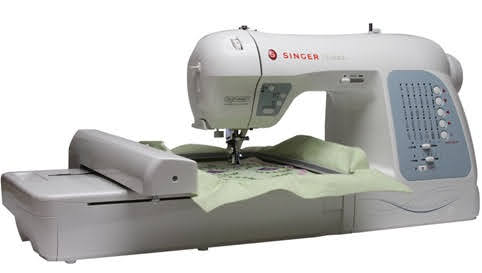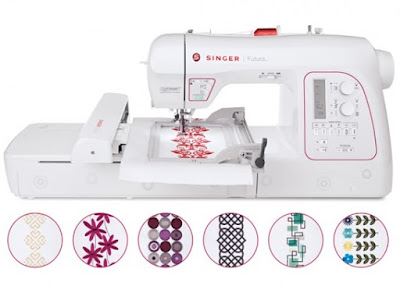Product Review ~ Singer Futura XL400 Embroidery Sewing Machine
I’ve had this machine for a few months now, have embroidered several designs from simple words to detailed designs of over 60,000 stitches, endured a few frustrations over it, but overall I love this machine. My first embroidery machine was the Singer Futura CE250, so I traded up for the Singer Futura XL400. It has it’s pros and cons, which I’m going to thoroughly address here. I’m also going to give a few helpful hints, tips, and tricks on operating the machine.
If you've lost the software to your machine, check out my post here.

Hint: Sometimes all you need to do is tighten or loosen the thread and it will stop beeping. Hold the thread with your fingertips very loosely until it stitches for a while without beeping, then you can let go. Also, check to see if the thread is tangled around the thread holder.
Thread holder is not firm. The thread cannot stand upright. If it does, it gets pulled and wound up around the holder.
Hint: Place the large spool pin cap upside down toward the top of the thread holder, place the thread on it, making sure it fits all the way on the holder, then place another smaller spool pin cap on the other side of the thread. (See photo below) 

Pros:
- Swift Smart Threading System makes it a breeze to thread. Instead of going up and down through the threading system, you simply go down.
- I love the Drop and Sew Bobbin feature, too. Instead of pulling the bobbin thread up with the needle, you simply put it through the space provided and it cuts it off for you. No need to pull it up with the needle.
- I like the snap on hoops, rather than the ones you have to screw in, like for the CE250.
Hint: If your machine shows a message that the hoop is not the correct size for the design when it clearly is small enough to fit in the hoop, then you may need to make sure it is in all the way. If you have not started a design yet, turn the power of the machine off, take off the hoop, turn on the power, then put the hoop on. This should fix it.
- I like the multi-hoop capability, but wish it was easier to line up. This and the larger hoop were the reasons I sold my CE250 and bought this one instead. The large hoop has an area of about 6.5 by 10.5 inches. It has multi-hooping capability, which I have not tried yet, but can have four large hoops in a square. The Features page says 18.5 by 11 inches. The small hoop has an embroidery area of about 4 by 4 inches. In regards of how many stitches a design has, the largest embroidery design that I used on this machine had over 60,000 stitches with no problem.
Hint: Use the print feature to help align the design where you want it. If you are embroidering something that needs to be centered but it’s on a small piece of fabric, you can use a large piece of fabric, embroider it, then cut out the fabric to the size you need. Or you can use spray on adhesive to keep the small piece of fabric in place on the stabilizer. If you are using embroidery for a quilt (stippling), use disappearing ink to measure where the hoop needs to be.
- The automatic needle threader is a good idea, but I like the one on the CE250 better because it seemed to work a lot better. My favorite is the one on the Quantum 9960, which I will review in another post. The one on the XL400 is very picky. I'm lucky to get it on the third try.
You have to practically put the thread into the little catcher thing, straining your eyes doing it which defeats the purpose of an automatic threader.Update: The reason it is so difficult is because while threading, it has to be caught on the tension disks in order to thread the needle properly. 99% of the time the tension disks do not catch the thread, therefore you have to hold the thread tight while threading the needle. Also, make sure your needle is in correctly. The CE250 wouldn't even let you put it in wrong. So when I first got the XL400, I put the needle in which ever way it allowed me to, which happened to be the wrong way. So the automatic threader wouldn't work at all. Some pressure feet wouldn't work, either. I finally had a light bulb come on and realized that I might have the needle in wrong. Remember: Flat Back—the flat side of the needle faces towards the back.
Hint: As shown in the photo below, hold the thread with your left hand as you push down the threader and hold the other end of the thread with your right hand.
- Strange as it is, my favorite feature on the XL400 is the speed control. When embroidering a design, you can set the speed from very slow to very fast. I normally set it about 1/3 between slow and fast. If it is too fast, the design does not come out as well—there’s a lot of bobbin thread that comes up.
Cons:
- Editing and autopunch software isn’t included with the basic software as it did with the CE250. You have to purchase it separate and it's quite expensive. It isn't compatible with the CE250 software, so if you already have all the software from CE250, it still won't work with it. You have to repurchase it. I use a free program for my editing, Stitch Era Universal.
- It is very clanky and loud when the hoop moves on high speeds. I wish it was quieter for when I am embroidering late at night when everyone else is sleeping. Of course if I’m embroidering during the day, it’s no problem.
- Message System is not very reliable. It beeps at me constantly when there is no thread break. I have a thread net and spool cap for my thread, which used to fix the problem with my CE250, but it doesn't seem to make much difference with the XL400. When it is not even close to running out of bobbin thread, it will beep, but when I completely run out of bobbin thread or the top thread breaks, it doesn't beep until after at least 8 stitches have past after the break, and you
can'tgo back to fix thatunless you do it manually. Update: There are a back button and forward button on the machine, so if it runs out, you can go back.

Hint: Sometimes all you need to do is tighten or loosen the thread and it will stop beeping. Hold the thread with your fingertips very loosely until it stitches for a while without beeping, then you can let go. Also, check to see if the thread is tangled around the thread holder.
Hint: Place the large spool pin cap upside down toward the top of the thread holder, place the thread on it, making sure it fits all the way on the holder, then place another smaller spool pin cap on the other side of the thread. (See photo below)


Would Improve if it Had:
- A feature that would really improve this, other than the above mentioned, would be an automatic thread cutter, as the Quantum Stylist 9960 has. Otherwise, you are wasting a lot of thread because you have to pull the entire hoop off before you can cut it. So if you are taking it off just to check the bobbin, you have to either rewind the bobbin to save that thread that you have just pulled up, or you waste it.
- Better Software. Being able to digitize from scratch would be nice. And a simpler, more user-friendly interface would be nice.
Overall, the machine is pretty nice. Other than the above problems mentioned, this would be the perfect embroidery machine, within this price range. I have not even used it as a regular sewing machine because I have my Quantum 9960 for that. When I had the CE250, it was the only machine I had. I didn’t like going back and fourth with taking apart the embroidery part of the machine and setting it up, then taking it apart again to use it as a regular sewing machine. I wish Singer had an embroidery machine that only did embroidery, cut out the special features for a sewing machine, therefore cutting the price and the extra pieces that it comes with.
I hope my review has been helpful.
Videos:
IntroductionHelpful links:
Singer Futura XL-400 product info
Singer Futura XL-580 Support
Singer Futura XL-580 product infoSinger Quantum Stylist 9960 product info




